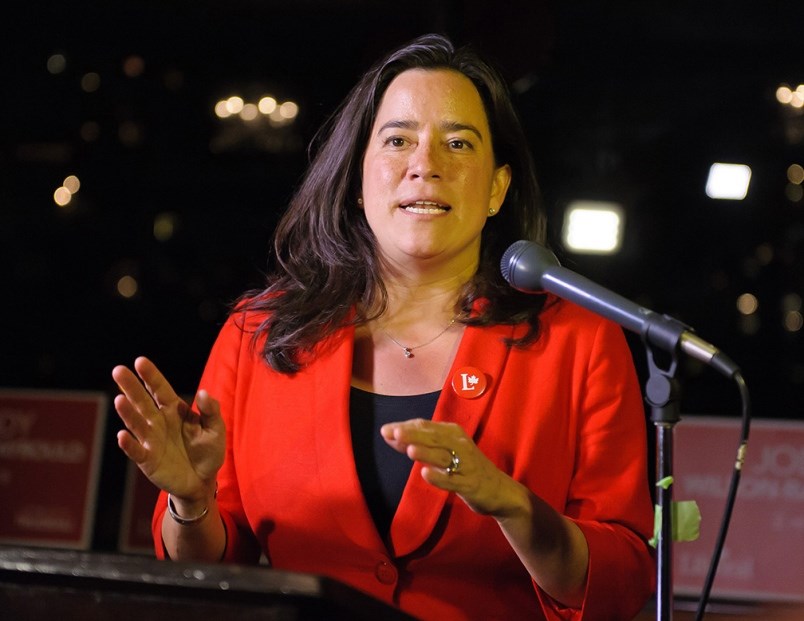It’s easy to make virtuous statements when you’re not even the official opposition.
“The Great Bear Rainforest is no place for a pipeline,” Justin Trudeau tweeted in 2013. Now that the Liberal leader is prime minister, apparently the GBR is just the place to slap down an LNG pipeline.
In 2012, Jody Wilson-Raybould attended a protest against development of the Site C dam (which is integrally connected to LNG development). As regional chief of the B.C. Assembly of First Nations, she admonished the Tories for a plan that threatened to run “roughshod over Aboriginal title.”
Now justice minister in Trudeau’s cabinet, Wilson-Raybould is keeping mum on the topic.
Last week, federal Environment Minister Catherine McKenna parachuted into Richmond with two other cabinet members to announce the fed’s approval of the Pacific Northwest LNG project, with 190 conditions attached.
If it goes ahead — a big if — the projected LNG project will ratchet up hydraulic fracturing for shale gas in northeast B.C., which the journal Seismological Research Letters has identified as cause for 90 per cent of 3.0-plus Richter scale earthquakes in the area. A Harvard study linked U.S. shale gas operations with a huge 10-year spike in global concentration of methane — a greenhouse gas 86 times more potent than CO2.
You don’t even have to buy into the authorized narrative of climate change (I’m looking at you, physics professor Freeman Dyson) to question the Rube Goldberg economics in play.
A few years back, Petronas CEO Shamsul Azhar Abbas demanded tax concessions as a precondition to proceeding with LNG operations in B.C. Suddenly, Premier Christy Clark’s much-ballyhooed $100-billion “prosperity fund” shrank to a numerically nondescript “chance… not a windfall” in the 2014 throne speech, read by Lt.-Gov. Judy Guichon. “The core services this government provides need to be protected,” she added.
At that time, the B.C. government’s boardroom romance with Petronas started to resemble Stockholm Syndrome.
In demanding tax concessions from B.C., Petronas was simply practising the kind of “free trade” brinksmanship that pits one nation’s treasury against others. But to be fair to the company, they were dealing with a tough fiscal reality: the Asian spot market price had plunged from $18.50/mmBtu in 2012 to below $11/mmBtu in 2014. (LNG prices have dropped more than 70 per cent in the past two years.)
Additionally, a 2013 internal audit by Petronas of their Malaysian operations reported “catastrophic” safety issues involving “severe” corrosion of pressure containers and lack of staff training. So there’s that troubling aspect of this low-margin industry, too.
When asked last week by CBC’s Carol Off for evidence that the Pacific Northeast LNG project will prove to be viable for B.C. taxpayers, deputy premier Rich Coleman responded, “There are studies done on worldwide markets on a regular basis by differing groups... we know each decade what level of capacity will be required.”
That takes balls to say. As in crystal balls. It suggests there are dependable extraction/depletion projections for the entire planet, many years into the future — and/or the global oil and gas market is manipulated from the very top into perpetuity. But with a noncompliant Sinosoviet player in the energy chess game, let’s give this commodity sooth-saying a probability of around 15 per cent, with a margin of error of who the frack knows.
So this is the plan. We’re prepared to lock the province into a 25-year tax and regulatory regime, which future governments will have to observe or pay compensation to Petronas. The claimed effects of fracking were noted above. And in part because natural gas liquefaction requires enormous amounts of energy, the province will ratchet up hydroelectricity capacity by developing the Site C Dam, with a $9-billion hit to the B.C. taxpayer.
Petronas will ship liquefied Canadian gas from its planned Prince Rupert terminal to Asian markets that already have natural gas suppliers in closer proximity. Yet currently the traditional energy sector is globally under pressure from glutted markets, cost-competitive alternative energy technologies, divestment campaigns and indigenous resistance to environmentally-compromising resource extraction.
It’s all a smoky plume in the form of a question mark. Petronas has yet to make a final decision, and other private players have either bowed out or are playing the waiting game on provincial investment. The B.C. LNG economy remains as vapourous as the Cheshire Cat’s grin.
mwiseguise@yahoo.com
geoffolson.com



